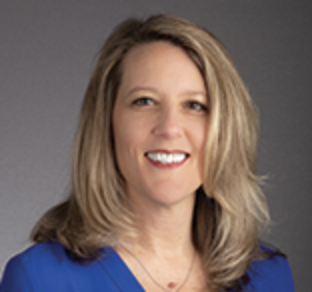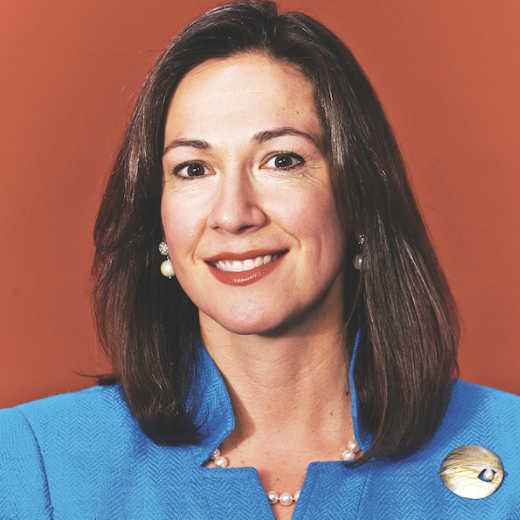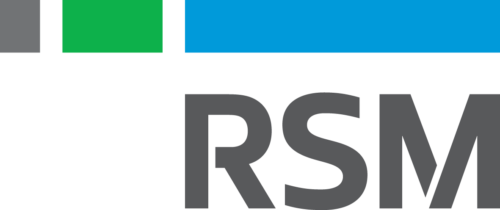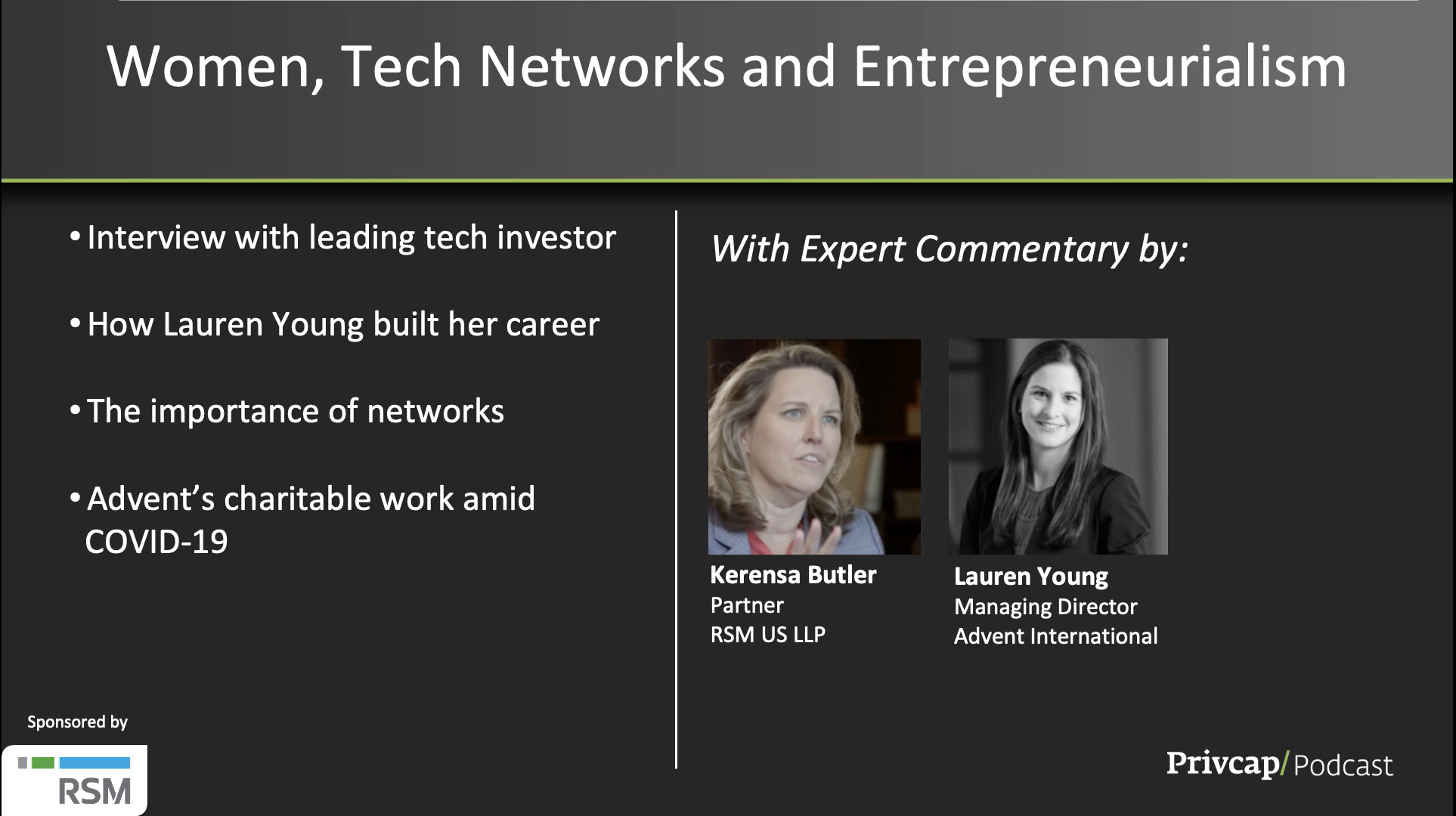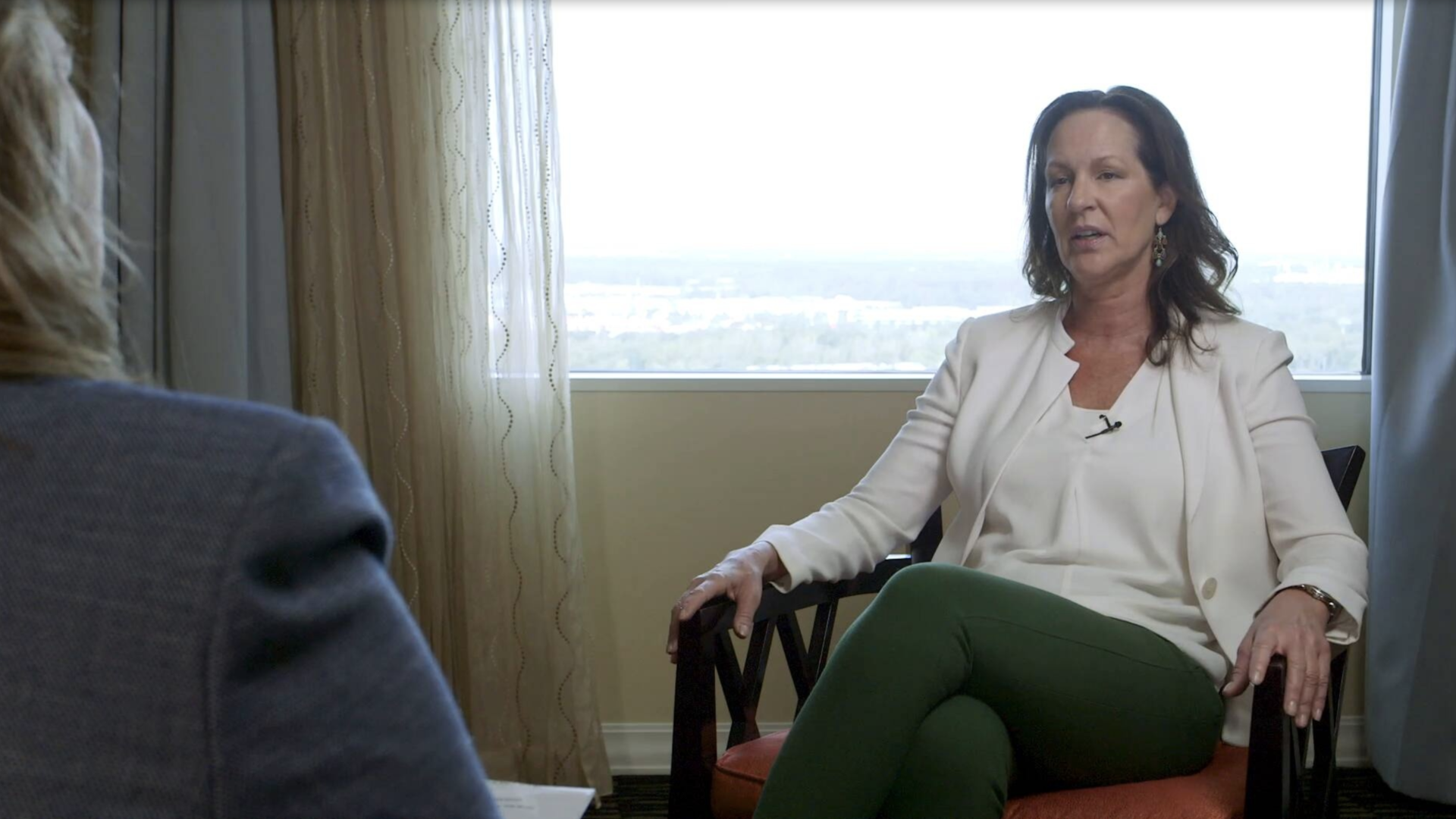Diversity, Equity and Inclusion in Private Equity
A conversation between Victoria Budson of Bain Capital and Karen Galivan of RSM. How can alternative investment firms put in place new hiring and promotion practices that broaden the diversity of the industry? How should women returning from maternity leave be given equal footing within an organization? Why do organizations with diverse employees perform better? What is intersectionality and why is it important? These and other important questions are discussed in a detailed, lively conversation.
Transcript
Privcap Transcript
“Diversity, Equity and Inclusion in Private Equity”
Karen Galivan, RSM US LLP: Victoria, you’ve done extensive work advocating for women in the workplace. What motivated you to begin working in this space?
Victoria Budson, Bain Capital: I’m someone who always thought it seemed odd that our world was divided based on gender, based on race. Even when I was a young child, it seemed as arbitrary as having redheads play football and people with brown hair play soccer. It just seemed a funny way to structure the world. So I’ve always been interested in different ways that we can build gender equity and racial equity, and how to create an environment where each and every person can make their full contribution, whatever the field or sector they are interested in.
Galivan: According to the World Economic Forum, gender parity will not be attained for another century. The pandemic only compounded the income and wealth struggles for women. Why do you think the pandemic caused such a major setback?
Budson: The pandemic really exacerbated and highlighted the problems that we have. And it deepened entrenched behaviors, whether in the workplace or at home. It was a perfect storm for women who had made gains within industry, but continued to need to do a second shift. I’m often aware that I do the full job that my father did, meaning that I’m a primary breadwinner. And I do the full role that my mother did, meaning that I’m a primary caregiver. Many women across societies throughout the world have both of those roles. The pandemic created a situation where women’s caregiving increased because caregiving that took place within the home became a 24/7 situation. For many parents who previously had the opportunity for their children to be cared for in school or within daycare, that was no longer available. Women’s roles at work continued and women’s roles at home increased. So you had a rise in both at the same time.
Historically, when the needs of the family rise, women rise to meet them. There’s sometimes discussion that these things are predetermined or biologically destined. We don’t see evidence of that. What we see is that people in society function in the ways that are expected and required of them. Historically, and continuing to today, the requirements of care have gone up and women have met those needs. We have to ensure that the whole safety net around care for dependents – whether that’s children, elder care, whatever people’s needs are, whatever familial needs are – that all of our employees have access to services to support that.
We need to make it easy. What is the commute for people to come into work? How can we build in flexibility? How do we structurally ensure that we provide all of our employees opportunity?
Historically, when individuals return from parental leave, people have what’s called benevolent bias. They might say, I’m sure that person is so busy – I’m not going to give that female worker, who’s just returned from leave, a big stretch assignment, because I don’t want her to have too much with her care responsibilities at home. We all know that the stretch assignments are the pathway to promotion. How do we ensure that we’re continuing to give all of our workers those opportunities?
We need to create systems that can be flexible, whether that’s onsite childcare, whether that’s systems and services to provide advice or matching for elder care?
Galivan: I had a colleague who was a consultant, and he had a team where both women were on maternity leave and came back. And I asked, how are things going? He said, I’m exhausted. I keep doing all the travel because I’m sure they just don’t want to do it, because they’re home with their newborns. And I looked at him and I said, did you ask them? You need to have those conversations to figure out some of those steps that you’ve outlined for us.
Budson: There are a few best-practice tools. For example, when people return [from parental leave], they should have a direct conversation with their manager about whether they are ready to dial up, dial neutral, or dial down. In best-in-class organizations, the manager then communicates clearly to the team. For example, Karen has just returned from leave. She’s going to return to leading X, Y, and Z projects. She’s going to be the tip of the spear on these next three initiatives. There’s a clear signal that we value that employee. There are some organizations where, as part of their best-in-class work, they review every individual who’s come back from parental leave and determine whether they are ready for promotion. There’s both the clear signals to the team and the clear signals to the employee that they’re valued and that their contribution should continue.
Galivan: We always hear that more diverse organizations are also more successful and profitable. Why then do you think the gender parity gap isn’t shrinking faster?
Budson: What we know in the fact-scape is often not what governs our sets of behaviors. And there’s also momentum and inertia. Most organizations tend to function as they have functioned in the past, whether or not it is in the most rational set of actions.
You should begin by doing an assessment. What is the benchmarking for our industry? What talent is out there? And then benchmark the sources from which we recruit. For example, in the private equity industry, it’s very common to recruit both out of business schools, as well as out of undergrad, for analyst programs. Perhaps also from consulting or banking. When we are only building a pipeline, considering the percentages from those institutions, we have tied our hands a little bit. We want to make sure that we see what talent is out there, and whether there are new sources that we can approach. Many organizations are using partners to help with recruiting. Partners like Out for Undergrad, Management Leaders for Tomorrow, Seize Every Opportunity – SEO – Girls Who Invest, Out Investor, Level 20. There are many, many more. These are partners that can help organizations get it right, and can cut down on work. And of course, organizations need to remember that as they build those pipelines, they’re building systems that will become well-organized, high-productivity systems that you don’t need to keep building anew with each hire.
As an industry, we’ve done a great job breaking down barriers to entry. When we bring in a whole analyst class, we’re very conscious that we want diversity – people from different backgrounds, different skill sets, perhaps different regions and perhaps different nationalities. People who speak different languages. But when it comes to promotion, we tend to choose what replicates the status quo, who is more like ourselves or is just common within the industry. And though that often can yield good talent, it will not consistently yield the best talent.
Organizations that are more diverse tend to perform better for two reasons. One, we know that complex questions are best answered from diverse perspectives. You’re more likely to get it right. For simple questions, you really don’t need a diverse group. You may have a diverse group from a moral or ethical frame, but you don’t need it to get it right. But for complex questions, the more perspectives and backgrounds represented within the group answering the question, the more likely we are to get it right.
When organizations promote people, it is often one at a time, rather than looking across a broad section of individuals in an analyst class. Sometimes we’re in a rush. Sometimes we make assumptions. Best-in-class organizations don’t just look at an individual and say, is John ready for promotion? Or, is Martha ready for promotion or is Laquisha ready for promotion? Instead, they look at all possible individuals at that grade who could be promoted. They have a core set of predefined metrics around experiences, education and performance. And then they literally do the work filling in that Excel grid.
When we have the conversation about whether a candidate is ready or the right fit, we tend to gloss over the facts. We don’t do it on purpose, but all of our minds work that way. By using a metrics-based system, we’re much more likely to get it right.
So we want to build in structural success, not just try to de-bias ourselves. It’s a long process and there’s not a lot of evidence that de-biasing ourselves as individuals yields really different roles.
Galivan: When people take leave, if flexibility is not there, then it’s sometimes hard to meet the criteria for promotion. For example, networking is always a very big part of PE or investment firms or accounting firms – anything in the financial space. But if you don’t have time to network, then you’re never going to be able to fill in that box. And if no one is going to bring you along, then you aren’t going to have that skill set. So you need to make sure that people have the opportunity to check those boxes.
Budson: Karen, you’re exactly right. Mentorship and sponsorship, along with networking, is key to helping people successfully navigate their careers. Organizations should go right from employee onboarding to a mentorship or sponsorship program. People who aren’t the norm in a position are less likely to get real-time feedback so that they can course-correct or gain new skills. A sponsorship relationship is, in essence, looking around the corner and telling you about opportunities you might not be able to see. What they can do is identify the key skills that you’re going to need to make it to that next level, and to match people with opportunity.
Sometimes there’s a myth of having the perfect mentor or the perfect sponsor or having those long-term relationships. You should think of it more as – who can help me today? Who can help me with this particular issue, even if it’s a moment in time? Rather than what everyone aspires to, which is that long-term, meaningful relationship. One can have a micro-sponsor experience, or a micro-mentorship experience.
And then there’s peership. People tend to skip the learning that they can have from others right at their level, who might be slightly ahead or have had some varied experience that they can learn from.
Galivan: I call that my personal board of directors – people within your organization that are close to your level, or just ahead, that you can just talk to and get ideas from. And also people outside your organization to give you a different perspective, who are not necessarily biased to the culture that you’re working in.
We’ve seen investors requiring more from companies than just saying they have DEI initiatives. How do companies move from saying they have these policies in place to acting those out – walking the talk.
Budson: Leaders want to get it right, and organizations wish to deepen both their diversity, as well as their equity and inclusion, and the sense of belonging that comes from it. But they don’t know exactly what to do, how to do it, how much time it will take, what it will cost, where they should begin, how to scale it, or how to build that virtuous flywheel. So with each action they’re learning.
The first step is doing an internal diagnostic. When you go to the grocery store, you’re going to have a list because you’re going to need certain ingredients in order to bake a cake. You are going to make sure with your diversity, equity and inclusion, that you understand what it is you’re trying to create before you start doing programming and activities. Sometimes people just say, we’ll do a bunch of activities and programming and we’ll measure some things. You can do that, but you’re not likely to get a high-yield result. Nor are you likely to understand what is contributing to your effective reaching of KPIs or major business objectives, versus what are nice-to-haves. So you want to begin by doing diagnostic work, so then you can see where you need to go. It might be that you have representation, but you’re not harnessing the diversity of ideas, which your team could avail you of. You need better inclusion practices, and people need to have more voice.
It might be that you haven’t been able to capture diverse talent, and through the building of pipeline programs, working more effectively with your recruiters, changing where and how you advertise your roles, you could capture a broader, more effective set of a talent force to join your organization. It may be that you can hire in, and that you’re able to get some of that inclusion, but you lose people past level seven. And right before someone moves from VP to MD, people choose to leave. In that case, you need to work on a retention strategy. You want to get your finger on the pulse, so your metrics are guiding you towards action.
Once you’ve put the metrics piece in place, you want to build out a strategy. Your strategy should not be off to the side. Your strategy should support your core business objectives, diversity, equity and inclusion, in addition to a really important moral and ethical framework of how you want to operate. It’s a tool. It is a set of arrows within your quiver that you can use to effectively build your business, whether it’s entering new markets, whether it’s developing new products, whether it’s supporting your portfolio companies.
You want to then have that strategy align with your programming, your inclusion activities, your employee resource groups, so that you’re building, moving forward.
In addition, it’s really helpful to have an engagement survey so you have direct knowledge of how people are experiencing the organization. You can then see whether you have pockets of really high success, where people feel inclusion and belonging, and you may be able to draw best practice from those. And you can look at areas that might need some work.
As our communities of LPs and others are asking questions of private equity and alternative asset management organizations, we’re really on a learning journey together. Which questions guide us to what actions? What additional questions may be very useful? As a global community within alternative investments, how can we share best practice, and not just learn from each other, but learn from other models and other industries as well?
Galivan: Many companies have DEI in their strategies. Their hearts are in the right place, and they’re even trying, with pipeline building, to make sure that they’re getting those diverse perspectives. But if you don’t have any metrics set up, it’s really difficult to then be accountable and hold the rest of the organization accountable to make change. . .
Budson: I think that’s exactly right. You need accountability and benchmarking against our industry. As we do better as a whole industry, where else should we be looking? And how do we ensure we aren’t counting for counting’s sake?
Within engagement surveys, one of the core things I suggest is to look across all of the questions and see, when you disaggregate that information, do you have differences by gender? Do you have differences by office? Do you have differences by language spoken? Do you have differences by generation? See what you can learn and glean from it.
Meeting our workforce where they are, and building our efficacy, is an ongoing process. There is some really great research about how different generations are engaging in the workplace. As we return to office, what are expectations? Who is geographically rooted and who thinks it would be great if we had no face time in the office? For most organizations and industries, it will take a combination of both to be at our best.
Galivan: You’ve spoken directly to the US House of Representatives. From a public policy standpoint, is there anything else that can be done that you think would be helpful to make sure that people have reached equity?
Budson: When we look both in the US and abroad, all nations continue to have differentiation and a lack of full equality under the law for people with differences. This means that men and women don’t hold the same rights across every nation and across every state or province and, to some extent, even across localities. So how do we bring our legal structure and framework up to date so that each and every person has the same set of protections, the same set of opportunities and the same ability to contribute to society?
My framework is about removing barriers for people to fully contribute, which is a slightly different lens than, what am I entitled to? And how does my status as whatever-I-may-be impact that? Both are really important. From a US regulatory framework, we’ll see more attention paid to the application of tools within alternative asset management and the finance industry.
Statements and aspirations will give way more fully to an expectation of, show me how you are making progress. Demonstrate the tools that you are applying and how you are holding people accountable.
One more note on accountability: Many engagement surveys are written where in essence, the employee is the consumer. How am I experiencing the culture? Do I feel a sense of belonging? That should be married to phrasing and language saying that people also rate themselves for how they are contributing to the culture of inclusion. What are the action steps that I am taking so that my colleagues feel a sense of belonging, feel that their voices and different opinions or perspectives are valued?
Galivan: From a personal standpoint, as women, we’ve all been encouraged to lean in. But leaning in only goes so far. What are some other things that we can do to make sure that we’re building that more diverse culture in our own organizations?
Budson: I’m going to quote a colleague of mine who said, if I lean any further, I’m going to tip over. Each of us may have opportunities where we can ask for that stretch assignment, or we can take advantage of opportunity. But be aware that within every culture organizationally, asking for more is not always viewed with the same positive response. We need to educate our whole organizations that when individuals are asking for something, that is a positive thing, as opposed to making more work, or being aggressive. How people hear things varies. For example, in a job negotiation over salary, the research shows us that if a man says, I believe my skills are worth 10 percent more, whether or not the hiring manager gives him 10 percent more, there is no residual negative effect for the question having been asked. But when a female or a person of color – someone who is not the norm in the role – asks for additional compensation, whether or not they received that, they may be viewed as someone who is less desirable with whom to work.
We have to teach everyone that asking – leaning in – is positive. Everything we do is intersectional. Whether we identify as being female or male or non-binary, we are also of a geographic region or of a generation. As we’re working on all of these tools to help our organizations, to help our individual careers, we have to be mindful of intersectionality.
Most organizations are doing implicit bias training. Implicit bias training is very much like going to the store, to use that same analogy, and bringing home the ingredients. But inclusive leadership practices take modes and methods of working that are inclusive, then turn those ingredients into inclusion and opportunity. We have to take it to that next level. We have to actually look at outcomes. Asking employees to lean in – that’s great. But when we measure and see how many women, how many women of color, how many men of color, make it from one level to another, that’s where the proof is.
Sometimes people imagine that DEI efforts are for those employees who somehow are different, whether they’re female, whether they’re people of color, whether they’re first generation or LGBTQIA. But when diversity, equity and inclusion is done well, it helps each and every employee. It provides equity which isn’t for some individuals, but is for each and every individual within the organization, so they have the tools they need to progress in their careers. They get the feedback that they need. They have the growth opportunities that they want. No one should ever feel that they are left out of, or not at the center of, the discussion for diversity, equity and inclusion practices. It’s for everyone.
